About UsOur Cattle Business ModelOver the last 30 years the Seed Stock industry has progressively increased the size of their cattle on the assumption that bigger is better and generates more profit. The questions which are currently being asked by some producers and needs answering are – are our breeding cows getting too big, with reduced fertility, consuming too much food, reducing our carrying capacity, reducing our calf weaning weight to cow weight percentage and thereby, most importantly, reducing our profitability. Our experience would indicate the answer to each of these questions is a resounding YES. As a business we are not going to continue in that direction viz: which is towards larger, higher input cattle with reduced fertility and reduced profitability. Our objective is to produce quality “Balanced/Optimal” Bulls and whenever possible, females for “like minded” beef producers in Australia and overseas. |  |
 | Furracabad StationFurracabad Station comprises 6750 acres located south of Glen Innes, New South Wales, Australia, at the head of Furracabad Valley and Mathieson Valley. Soil comprises rich black basalt flats rising to red basalt high country and has a northerly aspect. Rainfall is approximately 900mm per year. Altitude ranges from 1050m to 1275m. Furracabad runs a Angus, solely grass fed, breeding herd of approximately 1200 self-replacing females. |
Some philosophies being adopted by our cattle business are:
- To manage the natural resources of Furracabad in a natural and regenerative manner.
- To achieve a balance between the soil, grasses, water, sunshine and our cattle.
- We believe healthy living soil, healthy grass, healthy water = Healthy Cattle.
- We do not use chemical fertilizers, we use compost fertilizer
- To ensure maximum soil health we utilize a mix of numerous grass species and legumes. Monoculture practices are not permitted as they reduce soil health.
- As moderate Framed Cattle eat less grass than larger Framed Cattle, we can run more cattle and therefore increase profit.
-
Maximise rainfall penetration and holding in the soil by increasing the soil carbon content.
-
Utilize Rotational and High-Density Grazing Practices – this is the process of creating smaller paddocks and moving the cattle more frequently. This method encourages non-selective grazing because the cattle consume a more diverse diet, including non-desirable plants. This method also results in a better distribution of cow fertilizer. In addition, this technique increases hoof action, resulting in higher carbon levels in the soil. Higher carbon levels allows for greater water holding capacity and extends the growing period. The pastures also recover faster with shorter and more intensive grazing and are able to produce more grass.
-
Regeneration of Soils and Soil Health - includes encouraging all types of microorganisms to flourish, creating more diverse, and stronger, plant life. Bare soil cannot absorb as much rain as covered soil.
-
For fertilizer we apply a compost extract and dry minerals to increase the microbial activity in the soil. The impact of the compost extract is to encourage the proper balance of bacteria and fungi in the soil allowing plants access to soil nutrients. The overall goal is to have more quality, usable grass for the cattle, and for the soil to absorb more rainwater, making the grass more drought resistant.
-
Holistic Cattle Nutrition - mineral supplementation for cattle on grass fed programs The animal is allowed access to consume various minerals to optimize dietary intake and improve nutritional balance.
-
For the cattle operations to be both sustainable and profitable into the indefinite future.
-
For those people and major suppliers involved in the our business to share its business vision, goals and passion.
-
To continually educate and develop the employees of the business.
-
Optimum production verses maximum production – optimum production is always more profitable than maximum production.
-
To achieve optimum production you first must have cows that fit their environment and available feed resource and progeny that meets the market you are targeting – you do not attempt to change/supplement the environment and feed resource to fit your cows and progeny.
-
The use of Low Stress Stock Handling methods.
-
We calve according to our feed resource and in line with nature – match the cows highest nutritional requirements to the pastures highest and best production.
We are extremely pleased with the effect the Pharo genetics are having in our beef cattle operations.